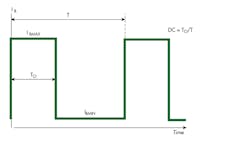Download this article in PDF format.
This article is part of TechXchange: Why Low Iq is the Smart Thing to Do
As it turns out, low IQ is a good thing. A least when you’re designing electronic equipment for low power consumption.
A device’s quiescent current, or IQ, is an important parameter to understand for battery-powered, energy-efficient designs. This article defines IQ and explains how it affects the design of switch-mode power supplies and the equipment they serve.
Sponsored Resources:
- IQ: What it is, what it isn’t, and how to use it
- Selecting a DC/DC Converter for Maximum Battery Life in Pulsed-Load Applications
- Quiescent Current vs Shutdown Current for Load Switch Power Consumption
IQ Defined
Quiescent current is that small amount of current required to keep an IC or other circuit operational. IQ doesn’t include any other input or output currents. IQ assumes a no-load condition. And as it turns out, this is the lowest amount of current drawn when the IC isn’t being accessed or used. It’s the least amount of current that a device requires to stay operational. And more importantly, IQ truly defines the total run time of the product.
Even in a standby mode of operation, quiescent current is flowing and therefore determines how long a battery-powered device will function. The discussion to follow is based on IQ in switch-mode power supplies (SMPS).
The power supply of a remote sensor, a wearable, or other battery-powered IoT device consists of a mix of dc-dc converters and regulators of the switch-mode variety. By their basic nature, they’re very efficient. Such devices typically spend a high percentage of usage time in a standby or sleep mode.
For example, a wireless sensor will occasionally wake up and transmit data back to the collection point gateway. The “on” duty cycle is very short, during which time current is drawn from the battery and supply. The “off” current usage then is predominantly the quiescent current of active devices in the product. That IQ will ultimately drain the battery. Thus, a critical design goal is to minimize IQ by selecting low-IQ devices and minimizing the “on” time during operation.
Here’s a list of things to summarize and clarify what IQ is or is not (assume that a battery and switch-mode ICs make up the main power supply):
- IQ doesn’t include any load current that exits the IC.
- The ICs are assumed to be in a non-switching condition.
- IQ is not no-load input current.
- IQ includes the current needed to keep internal circuits like reference voltage sources, oscillators, thermal shutdown or undervoltage lockout (UVLO), and logic circuits operational.
- IQ is partially derived from any input voltage to the IC.
- IQ is also made up of any current that exits the device.
- IQ is just the minimal overhead current that keeps the IC alive to function properly.
What follows are two examples illustrating how to increase battery life by properly dealing with IQ.
Selecting a DC-DC Converter for Pulsed-Load Applications
Many battery-operated devices such as IoT sensors, medical wearables, or remote metering equipment use dc-dc converters or regulators to establish to main supply voltages for the circuitry. Switch-mode ICs are used to ensure efficiency, reduce heat, and most of all, improve battery life.
An important consideration in designing such devices is to realize that most operate in a pulsed mode (Fig. 1). Most of the time, the device is off and drawing minimal battery current. Then, at other times, it powers up to transmit data or otherwise perform its designated function. The duty cycle (DC) of such a pulse power profile is the ratio of the power-on time (TO) to the full cycle time T:
DC = TO/T
Load duty cycles can be from 1 to 10-6 (0.000001) depending on the type of device and its operational profile.
To be more precise, there are three possible power scenarios:
- Heavy load, device fully powered up and functional. All SMPS ICs are working with pulse-width modulation (PWM) to switch the power transistors. Most devices are operating at full efficiency during this condition.
- Light load, a power-save mode of operation. Here, the SMPS ICs operate in short bursts to keep the output voltage alive.
- Shutdown mode, the SMPS ICs are completely switched off. The primary current consumption is from IQ.
It’s important to learn how to interpret efficiency for a battery-powered system under different load conditions in order to maximize the battery life.
The Value of Knowing IQ, or Not
A common design mistake is designing a battery-operated product is to focus only on the heavy load efficiency. During periods of inactivity, the power ICs using PWM are still consuming power. Maximum efficiency occurs during the heaviest loads. Some converter ICs feature a pulse-frequency-modulation (PFM) mode that’s enabled at low output power-save conditions to improve efficiency.
Keep in mind that IQ is just the current drawn by the converter IC but doesn’t include the current from the switching power stage. The current in the power stage is heavily influenced by components external to the IC; therefore, it’s not part of IQ. The input current to the IC depends on the overall efficiency of the IC plus the IQ. As the load current decreases, efficiency goes down and as a result, IQ becomes a greater percentage of the total input.
IQ values varies widely with the SMPS IC. It can be 20 µA or only a few hundred nanoamperes. Look for the highest efficiency and the lowest IQ when selecting an IC. The DC of the pulsed-load operation is also a factor. As DC decreases, IQ becomes a more important factor when comparing ICs.
The secret to juggling all of these factors is making precision measurements on the input and output currents, IQ, and DC under the different load conditions. It’s necessary to test competitive devices under different load, no load, and shutdown conditions to determine which IC gives the best efficiency given the specific type of end product and its application. In the meantime, take a look at Texas Instruments’ series of ultra-low-power dc-dc converters for battery-operated equipment (TPS61xxx, TPS62xxx). Their efficiencies run over 90% with a low IQ of 360 nA.
Quiescent vs. Shutdown Current for Load-Switch Power Consumption
A load switch is an IC containing a MOSFET switch that turns power from the rails off or on (Fig. 2). The MOSFET is in series with the main power rail. It connects the input voltage to the load when the ON input is high.
Load switches are particularly useful in larger equipment with complex power-distribution needs. The load switches permit the sharing of selected power supplies and even dc-dc converters or regulators. Load switches also easily facilitate load sequencing. Complex ICs and other multiple-supply voltage circuits specify that the dc power rails be sequenced on in a special order. Load switches driven by a microcontroller make sequencing easy.
Load switches can also be useful in controlling leakage current. In some instances, certain circuits or equipment when not in use draw leakage current from the supply. That leakage can be stopped by switching off the supply to the desired offending circuits.
Furthermore, a load switch can minimize rail voltage sag when power is first turned on due to capacitor inrush current. The load switch lets you disconnect the affected device or circuit until the power supply is fully ready to accept power. Finally, load switches can help implement a controlled power sequence.
It’s important to better understand quiescent and shutdown current and how they can be used to maximize battery life. The definition of quiescent current for a load switch is that it’s the current required to power the device in the ON state and is derived from VIN. IQ is typically negligible compared to the full load current.
Shutdown current is the current flowing from VIN when the device is disabled by the ON input. Even in a shutdown mode, that current may be a leakage current from a load. However, that leakage will be shunted to ground by the load switch, thereby greatly reducing overall power consumption. This is a feature of most load switches. This feature not only removes leakage, but also discharges any shunt capacitances when power is removed. Called the quick output discharge (QOD), it’s a MOSFET that will bring the output to zero quickly so that the output isn’t floating. Furthermore, all of the downstream loads served by the load switch are fully turned off.
Check out more articles in the TechXchange: Why Low Iq is the Smart Thing to Do
Sponsored Resources:



